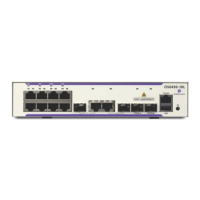page 21-20 OmniSwitch AOS Release 7 Network Configuration Guide March 2011
• The maximum queue threshold determines the delay a packet may experience while waiting for the
queue to clear out other packets that arrived first. A good rule of thumb is to set this value to twice the
size of the minimum queue threshold.
Configuring WRED profiles involves the following tasks:
• Creating a new WRED profile, if necessary, using the qos wred command. For example:
-> qos wred wrp-id 2 color g min 10 max 80 pb 2 gain 7 y min 20 max 80 pb 3 gain
7 r min 30 max 80 pb 4 gain 7
-> qos wred wrp-id 2 admin-state enable
• Changing the WRED profile associated with the QSet profile to which the WRED parameters will
apply. This is done using the qos qset command.
-> qos qset qsp-id 2 wrp-id 2
To verify the WRED profile configuration, use the show qos wred command. For example:
-> show qos wred
WRP 1 (wrp-1)
Admin: Ena, #Ports: 480, MTU: 1540
Red
Min-Th: 20, Max-Th: 90, Max-Pb: 36, Gain: 9
Yellow
Min-Th: 30, Max-Th: 90, Max-Pb: 30, Gain: 9
Green
Min-Th: 40, Max-Th: 90, Max-Pb: 24, Gain: 9
See the OmniSwitch CLI Reference Guide for more information about the qos wred, qos qset, and show
qos wred commands.
Traffic Policing and Shaping
Traffic policing and shaping mechanisms are used to limit the rate of traffic. The main difference between
the two is how they handle traffic that violates the specified rate. Policing either drops or remarks traffic
that exceeds a configured maximum rate. Shaping delays the transmission of packets that exceed config-
ured rates by placing the packets in a queue and scheduling them to be sent at a later time.
The OmniSwitch 10K provides the following techniques for policing and shaping traffic flows.
Policing
• QoS Tri-Color Marking (TCM) policy. A TCM policy consists of a policy action that specifies
packet rates and burst sizes. The policy condition defines the type of traffic for TCM to meter and then
color mark (green, yellow, or red) based on conformance with the rate limits defined in the policy
action. See “Tri-Color Marking” on page 21-21.
• QoS bandwidth policy actions. Maximum bandwidth and depth policy actions are used in QoS policy
rules to specify a maximum ingress bandwidth rate and bucket size. See “Configuring Policy Band-
width Policing” on page 21-23 for more information.
• E-Services bandwidth parameters. The VLAN Stacking Service Access Point (SAP) profile defines
an ingress and egress bandwidth rate limiting configuration for an Ethernet Service. See Chapter 27,
“Configuring VLAN Stacking,” for more information.

